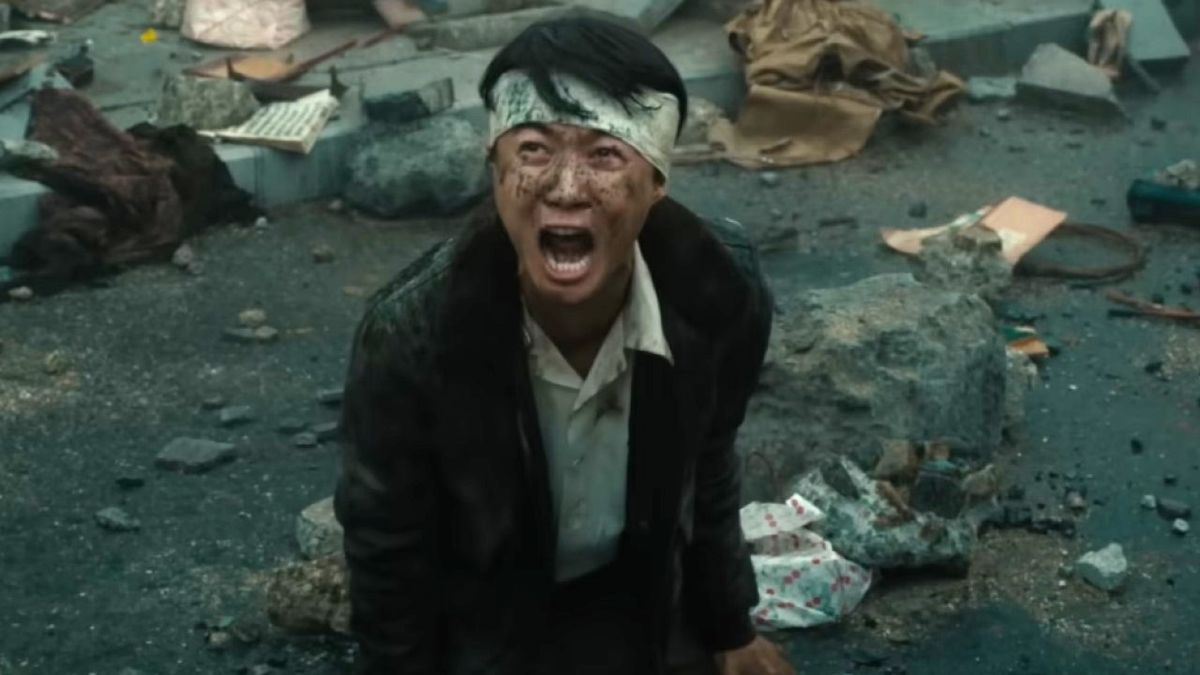
Godzilla Minus One is a rare beast. Despite being derived from a franchise that’s nearly three-quarters of a century old, and which has had more installments than there are days in a month, Takashi Yamazaki’s latest reinvention of the Big G feels fresh. It’s a true spectacle of emotion and cultural angst; a film that remarkably takes a piece of pop culture furniture like the giant irradiated lizard and makes him scary again.
In Godzilla Minus One, the titular creature is not only a dazzling sight of cinematic carnage candy, but he’s also a potent metaphor about war, destruction, and the psychic scars such catastrophes leave in their wake. It’s also just a gripping piece of entertainment that took the world so by storm that it convinced the Academy Awards to give Minus One the Best Visual Effects Oscar despite having a budget of less than $15 million (about 1/17th of fellow nominee Guardians of the Galaxy Vol. 3’s price tag).
In other words, the film was a phenomenon stateside in spite of the subtitles, and with Godzilla Minus One finally making landfall on Netflix in the U.S. this past weekend, more Americans than ever are getting to feast their eyes on what happens when you knock it out of the park in a movie about dinosaurs and atomic breath. However, Godzilla Minus One should be looked at as more than a sight for audiences to behold; it’s also a reminder to American studios about what you can achieve, even when revisiting well-worn franchises and intellectual property. Here are some of the key lessons.
Character Is King
One of the most impressive aspects of Godzilla Minus One which bears repeated celebration is its uncanny ability to develop characters who really impacted audiences. Traditionally in Godzilla and other giant monster movies—be they of American or Japanese origin—the human characters are time-fillers; they’re faces to provide exposition before the big monster fights and then otherwise pad out the running time.
And yet, the plight of Koichi Shikishima (Ryunosuke Kamiki), an erstwhile kamikaze pilot in World War II who couldn’t go through with throwing his life away, and Noriko Orishi (Minami Hamabe), a fellow survivor of the war and the devastating firebombings of Tokyo, provides a genuine emotional hook to the film. Their found family dynamic as a pair of proverbial orphans, who in turn must raise a literal one in the form of a baby Noriko discovered in the wreckage of their city, drives the film. As do many of the supporting roles which are often colorfully played, with each character enhancing the details of the film’s portrait of a society reeling from defeat and desolation.
While not every film can or should be about the aftermath of cataclysmic war—nor does even every Godzilla movie need to be a tragedy—the clear intent by writer-director Yamazki to sharply define compelling characters who give talented character actors like Hidetaka Yoshioka something tactile and human to latch onto, even if they’re in a tertiary role. Hollywood obviously has no shortage of great actors or writers, and most modern blockbusters are littered with talented leads and fantastic character actors in supporting roles. Yet the material they’re handed, often by studios determined to appeal to the broadest audience, is frequently substandard. Many times the results can be talented folks standing around spouting exposition between set pieces. And speaking of those set pieces…
Pacing Is About More Than Set Pieces
The desire to begin your action or adventure movie with a spectacular set piece is almost as old as Godzilla movies themselves. And Godzilla Minus One does not deviate from this rule. Its prologue deliberately builds to a terrifying moment where the eponymous monster slaughters a battalion of mechanics on a remote Japanese outpost during WWII. Yet it’s worth noting that even that carnage does not occur until the five-minute mark.
That might sound swift, but it’s pretty much in open defiance to the Netflix algorithm which has led streaming executives to ask directors to scrap elaborate opening sequences or shots because if “something doesn’t happen in the first 30 seconds, we know the data shows that people will just turn off.” More to the point, however, is that after that spectacular opening, Godzilla Minus One does not feature another major action sequence or Godzilla attack until the 38-minute mark. In other words, more than half an hour passes between set pieces.
This breaks from decades-old Hollywood wisdom which states there needs to be some type of set piece or action beat every 10 minutes in a four-quadrant movie (something that appeals to all audiences). These don’t always have to be on the scale of Tom Cruise hanging from the side of a plane, but they tend to require a pacing that’s restless and relentless—otherwise the audience might get bored. But Godzilla Minus One takes a leisurely approach to its first act, spending long swaths of running time just sitting in the day-to-day lives of its characters and emphasizing the dramatic heft of its story more than the visual scale. And even after it turns into a more traditional monster movie, Minus One does not hesitate to spend large chunks of its third act on Koichi reminiscing about the war with a mechanic just as traumatized and broken by what happened.
The film lets the story and its characterization dictate the pacing and action beats instead of the other way around.
Know What Your Film Looks like Before Shooting
Arguably the most impressive thing about Godzilla Minus One is the scale it is able to achieve on a minuscule budget. Admittedly, the different rates of labor and production between countries plays a factor in that success, but it’s still generally impossible not to be wowed by Godzilla Minus One’s action sequences when you know they cost a fraction of their Hollywood brethren.
This lesson is all the louder nowadays, too, given Marvel Studios’ current PR and labor woes coming to light after multiple damning reports about VFX artists being allegedly overworked and underpaid by the popular superhero factory, even as the visual quality of Marvel’s output has become increasingly inconsistent. Apparently a major factor in this situation is the studio’s assembly line formula coming to revolve around shooting a film with an unfinished script in front of blue screens all while expecting to figure out in post-production what the director (or producers) really want the scene to be. This in turn often necessitates heavy reshoots and down-to-the-wire VFX work and reworkings.
The approach would seem to balloon budgets and lead to VFX-heavy films turning out as ugly as last year’s Ant-Man and the Wasp: Quantumania. By virtue of its budget, Godzilla Minus One could not afford such indecision or behind-the-scenes chaos. While some of the best films were born out of the crucible of production woes (see the gold standard example of Jaws), more often than not you end up with a movie that’s just dead in the water.
Humor Does Not Need to Be a Crutch
Another relatively recent phenomenon apropos to Marvel’s house style—but also in line with the formula utilized by many other franchises at large, including recent American Godzilla movies—is an over-reliance on self-deprecating humor or comic relief to paper over the lack of emotional resonance or narrative depth in the material. Which is to say that American blockbusters have come to rely on “jokes” as a crutch for subpar cinema.
This is not a pox on any one film or franchise per se. Marvel’s early big hits like Iron Man and The Avengers even felt subversive in their day due to relying on the natural charisma and cheer of iconoclastic performers like Robert Downey Jr. (or Joss Whedon’s sometimes witty uses of intertextual gags). Yet what once seemed like a novel way of winking at the audience has become a ubiquitous formula throughout the industry to signal to audiences that they need not invest too seriously in the story before them—and by implicit extension hold the film to some unreasonable standard like being genuinely moved, thrilled, or provoked.
Godzilla Minus One is nothing but provocation. It insists audiences take the threat of a giant lizard stomping on a city as seriously as an atomic bomb, and it earns that conviction because its characters never attempt to undermine or dilute the concept with a proverbial nudge, nudge toward the audience.
Fantasies Can Still Be About Real Things
Godzilla Minus One is not the first Godzilla movie about the aftermath of World War II. The 1954 original directed by Ishirô Honda is still considered a masterpiece for how it created a potent allegory about the menace of nuclear testing in the shadow of Hiroshima and Nagasaki. However, Minus One makes that original idea fresh again by expanding its metaphor to an indictment of the modern industrialized war machine around the world. The film is almost as critical of the Japanese government as it implicitly is of the American one that dropped bombs on Japan and, in turn, began testing bigger thermonuclear weapons in the South Pacific.
The film is also about how to humanely live in the aftermath of such dehumanizing horror. Koichi’s trauma is also that of an entire culture that was lied to and manipulated into a devastating and ruthless war that has left its people either in the grave or with lifelong anguish. And it commits to this as readily as it does to the sight of Godzilla crunching down on an elevated train.
To be clear, American blockbusters are not altogether vacuous by comparison. In fact, the biggest movie of last year was a brilliant feminist allegory that somehow got slipped into what could’ve just been a commercial for a popular doll. However, Barbie’s success and ability to wow audiences belies that it is an exception to the rule—an exception which remains ever tenuous when ambitious American blockbusters like last month’s spectacular Furiosa can run out of gas on opening weekend. By and large, U.S. tentpoles are designed to be disposable and pat—it makes them easier to mass produce. But such cynicism also handicaps franchise movies, preventing them frequently from reaching the soaring heights of a Godzilla Minus One.
Spectacle Needs Human Scale
Godzilla is, of course, a spectacle. You can’t make a subtle movie about a giant lizard with atomic breath. Most American blockbusters are also spectacles, to the point that Marvel and Mission: Impossible scripts are constructed around their big set pieces. However, Godzilla Minus One understands that spectacle doesn’t work without people in the literal frame. We viewers don’t get dazzled by the abstract. We have to see ourselves in relation to the outsized.
During the young Godzilla’s first attack on Odo Island, Yamazaki includes plenty of moments familiar to kaiju fans, including Godzilla’s foot stomping on fleeing people, who get flicked away with his tail. But Yamazaki also includes insert shots of Shikishima and Tachibana frozen with terror, selling the emotional stakes of their inability to fight. Seeing them in the same shot as the monstrous Godzilla makes his size immense, and his threat tangible. Conversely, many recent American spectacles, be it the aforementioned Ant-Man 3 or this year’s Godzilla x Kong: The New Empire from Legendary Pictures and WB, are all too happy to just have “giants” and monsters bash each other in a CG vacuum where it doesn’t matter if King Kong is 50 stories tall or 50 inches.
Learn From, Don’t Copy
For much of its first act, Godzilla Minus One becomes a sea-faring adventure movie as the shamed Shikishima joins a crew tasked with removing mines from the coast. As Shikishima opens up, the dynamics between the men come into focus and add energy to shots of their boat flying across the water.
The boat subplot, of course, recalls Jaws, but not in any obvious way. No one crushes a can/cup or suggests a bigger boat. Instead of nudging the audience to show how cool he is, as so many American filmmakers do, Yamazaki learns from Steven Spielberg. He takes the lesson of the interactions on the Orca in Jaws and applies them to his movie, adding texture to the film without distracting from it.
The post 7 Things Godzilla Minus One Can Teach American Blockbusters appeared first on Den of Geek.





